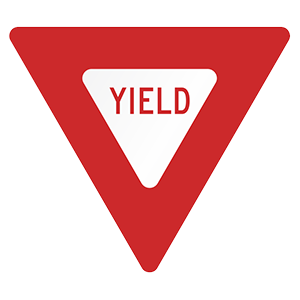2025 Iowa Permit Test 15
The following questions are from real DMV written tests. These are some of the actual permit questions you will face in Iowa. Each permit practice test question has three answer choices. Select one answer for each question and select "grade this section." You can find this button at the bottom of the drivers license quiz. For a complete list of questions and answers for Iowa please visit https://cheat-sheets.dmv-written-test.com/en/iowa/car.
Number of Tests
Number of Question
Passing Score
17. Continuous hard braking on ice and snow often:
Explanation
Continuous hard braking on snow and ice can result in the locking of the front brake, causing a loss of steering. To avoid the need for excessive braking, make sure to maintain an appropriate speed for conditions.
18. This red and white sign means you should:

Explanation
A three-sided yield sign indicates that you must slow down and be ready to stop, if necessary, to let any vehicle, bicyclist, or pedestrian pass before you proceed. In this case, you do not have the right-of-way.
19. If traffic signals at an intersection are not functioning due to a power outage:
Explanation
If a traffic light at an intersection is not functioning due to a power outage, yield to other drivers in the same manner as you would when approaching a four-way stop. When it is your turn, proceed through the intersection with caution.
20. Using a cell phone while operating a motor vehicle is considered a distraction because:
Explanation
Using a cell phone while driving is dangerous because it occupies the user's eyes, hands, and mind. Even the most skilled drivers increase their risk of being involved in a crash by using a cell phone on the road.
21. Double solid yellow line markings down the center of a road indicate that passing is:
Explanation
A double yellow centerline means that it is prohibited for traffic from either direction to cross the centerline to pass.
22. When driving in rain, you must:
Explanation
In rainy conditions, you should use your low beam headlights.
23. When passing another vehicle, you should return to your original lane when:
Explanation
When passing another vehicle, move back into your original lane only when you can see the passed vehicle’s headlights in your rearview mirror. This ensures that you will have enough room to safely pull back in front of the other vehicle.
24. Which lane must you be in before making a left turn from a one-way street?
Explanation
When making any turn, turn from the lane closest to the direction you wish to travel into the first available legal lane. If you are making a left turn from a one-way street, this means that you would make the turn from the lane nearest to the left curb.
Ranked by best match
